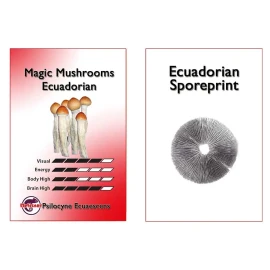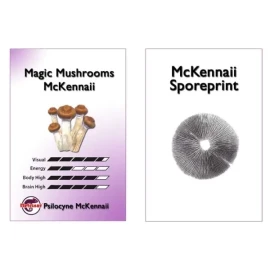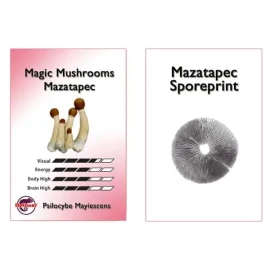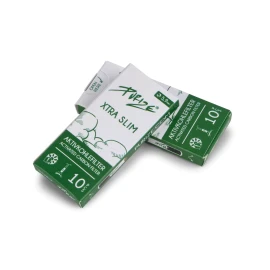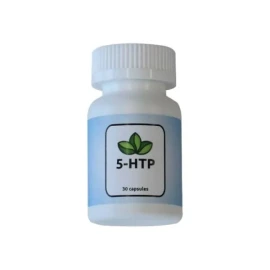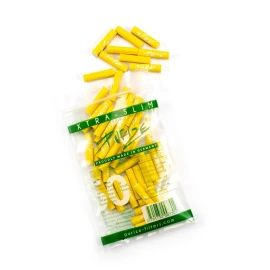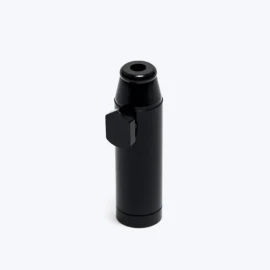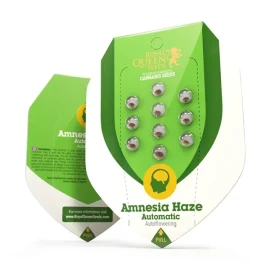Mazatapec Sporeprint
20,00 €
Product Overview
Authentic Mazatapec sporeprint for microscopy, taxonomy, and educational research — historically linked to Mazatec shamans in Oaxaca and recognized for consistent spore yield and reliable viability. This premium sporeprint represents one of the most culturally significant Psilocybe cubensis lineages, offering researchers and microscopy enthusiasts access to genetically stable spores with documented provenance.
Quick Specifications
| Species | Psilocybe cubensis — Mazatapec lineage |
| Spore Color | Dark purple-brown deposit |
| Typical Spore Size | ~7 × 12 µm (microscopic examination) |
| Viability | 12–18 months when refrigerated properly |
| Use | Microscopy, identification, educational research |
| Storage | Refrigerate in airtight container, avoid freezing |
| Format | Sterile sporeprint on foil, sealed with desiccant |
| Packaging | Tamper-evident sleeve with humidity control |
Historical & Cultural Context
The Mazatapec strain carries deep cultural significance, originating from the traditional practices of the Mazatec people in the mountainous regions of Oaxaca, Mexico. This lineage has been preserved through generations of Indigenous knowledge and represents one of the most authentic connections to traditional shamanic practices involving Psilocybe cubensis.
Archaeological and ethnobotanical evidence suggests the Mazatec people have maintained sophisticated understanding of fungal cultivation and identification for centuries. The strain’s name directly honors this heritage, and ethical sourcing practices ensure respect for Indigenous intellectual property rights.
Modern mycologists value Mazatapec sporeprints for their genetic stability and consistent morphological characteristics. The strain maintains distinct features that differentiate it from other Psilocybe cubensis varieties, making it valuable for comparative taxonomic studies and educational microscopy work.
Understanding Sporeprints
A sporeprint represents a deposit of millions of microscopic spores collected from a mature mushroom cap through natural spore release. These prints serve multiple scientific and educational purposes:
Taxonomic Identification: Spore color, size, and morphology provide critical identifying characteristics for species classification. The dark purple-brown coloration of Mazatapec spores represents typical Psilocybe cubensis characteristics while maintaining strain-specific variations observable under magnification.
Microscopy Research: Individual spores measure approximately 7 × 12 micrometers, displaying the characteristic ellipsoid shape common to Psilocybe cubensis varieties. Under proper magnification (400x-1000x), researchers can observe detailed spore wall structure, color variations, and morphological features essential for scientific study.
Educational Applications: Sporeprints provide hands-on learning opportunities for students studying mycology, botany, and microscopy techniques. The preparation of microscope slides from sporeprints teaches sterile technique, proper mounting procedures, and microscopic observation skills.
Genetic Research: Spores contain complete genetic material necessary for scientific analysis of fungal genetics, allowing researchers to study genetic variations between strains and understand evolutionary relationships within Psilocybe species.
Scientific Characteristics
Morphological Features
Mazatapec spores exhibit consistent morphological characteristics that distinguish them within the Psilocybe cubensis species complex. Under microscopic examination, spores display:
- Color: Deep purple-brown to nearly black coloration when fresh
- Shape: Ellipsoid with slight asymmetry typical of basidiospores
- Size Range: 6.5-8.5 × 11-13 micrometers with average 7 × 12 µm
- Surface: Smooth spore wall with characteristic thickness
- Germination Pore: Distinct apical pore visible under high magnification
Chemical Properties
The spore wall composition includes chitin and other polysaccharides that provide structural integrity and resistance to environmental factors. This robust construction contributes to the excellent storage stability observed in properly maintained Mazatapec sporeprints.
Spores demonstrate typical sensitivity to extreme temperatures, with optimal viability maintained between 2-6°C (refrigeration temperature). Freezing causes cellular damage through ice crystal formation, significantly reducing viability rates.
Sterile Collection Methodology
Equipment Requirements
Professional sporeprint collection requires specific equipment to maintain sterility and ensure high-quality results:
- Fresh mature mushroom cap with fully opened gills
- Sterile aluminum foil or microscope slides
- Sterile glass container or jar for covering
- Disposable gloves and alcohol wipes
- Flame source for tool sterilization
- Sterile tweezers or handling tools
- Desiccant packets for moisture control
- Sealable sterile storage bags
- Permanent markers for labeling
Collection Procedure
Preparation Phase: Establish a sterile workspace using alcohol wipes to clean all surfaces. Wear disposable gloves and avoid touching sterile materials directly. Flame-sterilize metal tools and allow cooling before use.
Cap Selection: Choose a fully mature cap showing complete gill exposure and spore readiness. Optimal caps display dark gill coloration and slight spore dusting around the stem attachment point.
Print Setup: Place sterile foil or slide on a level surface within the sterile workspace. Position the cap gill-side down, ensuring complete contact with the collection surface. Cover with a sterile glass container to maintain humidity while preventing air currents that could disturb spore deposition.
Collection Time: Allow 12-24 hours for complete spore release. Longer collection periods typically yield denser prints, while shorter periods may result in insufficient spore density for microscopy work.
Post-Collection: Carefully remove the cap using sterile tweezers, avoiding contact with the deposited spores. Allow the print to air-dry for 1-2 hours in a low-humidity environment before storage preparation.
Storage Preparation: Fold foil prints carefully to prevent spore loss, or transfer slide preparations to protective cases. Include desiccant packets in storage containers and seal immediately to prevent moisture accumulation.
Storage & Viability Maintenance
Short-Term Storage (1-6 months)
Store sporeprints in refrigerated conditions between 2-6°C in airtight containers with desiccant packets. Avoid temperature fluctuations that could cause condensation formation. Label containers with collection date and strain information for tracking purposes.
Long-Term Storage (6-18 months)
Extended storage requires enhanced moisture control and temperature stability. Vacuum-sealed packaging with multiple desiccant packets provides optimal conditions for maintaining spore viability. Some researchers recommend double-bagging with additional desiccant layers for maximum protection.
Viability Assessment
Regular microscopic examination allows monitoring of spore condition over time. Healthy spores maintain consistent coloration and cellular integrity. Signs of degradation include color fading, cellular collapse, or visible contamination growth.
Fresh sporeprints typically show 90%+ viable spores under microscopic examination. After 6 months of proper storage, viability rates generally remain above 70%. Beyond 12 months, viability may decline but often remains sufficient for microscopy and research applications.
Legal Considerations & Compliance
United States Regulations
Federal law generally permits spore possession for microscopy and educational purposes, as spores do not contain controlled substances. However, state laws vary significantly, with several states explicitly prohibiting spore possession regardless of intended use.
Restricted States: Georgia, Idaho, and California maintain specific prohibitions on Psilocybe spore possession. Additional states may restrict possession when combined with cultivation equipment or materials.
Legal Compliance: Buyers must research applicable state and local laws before purchase. Spores sold exclusively for microscopy and educational research remain legal in most jurisdictions when not combined with cultivation intent.
International Considerations
European Union member states generally permit spore possession for research purposes, though individual national laws may impose restrictions. Countries including the Netherlands, United Kingdom, and Germany typically allow spore sales for microscopy applications.
Import Restrictions: International shipping may encounter customs delays or restrictions depending on destination country regulations. Buyers assume responsibility for compliance with import laws and customs requirements.
Quality Assurance & Authentication
Vendor Verification Standards
Authentic Mazatapec sporeprints demonstrate specific characteristics verifiable through microscopy and documentation review:
- Provenance Documentation: Legitimate vendors provide clear strain lineage information and collection methodology details
- Microscopy Evidence: High-resolution spore images with scale bars confirm species identification and spore morphology
- Sterility Protocols: Detailed descriptions of collection and storage procedures indicate professional handling standards
- Customer Support: Responsive technical support and clear legal disclaimers demonstrate vendor professionalism
Contamination Prevention
Professional vendors implement multiple contamination prevention measures:
- Sterile Collection: All sporeprints collected using aseptic technique in controlled environments
- Quality Testing: Visual inspection and microscopic examination before packaging
- Protective Packaging: Sealed containers with desiccant and tamper-evident sealing
- Storage Controls: Temperature and humidity monitoring throughout storage and shipping
Microscopy Applications
Slide Preparation Techniques
Basic Mounting: Place small spore sample on clean microscope slide and add mounting medium. Cover slip application requires careful technique to avoid air bubble formation.
Staining Procedures: Various staining techniques enhance spore visibility and reveal structural details. Lactophenol cotton blue provides excellent contrast for spore examination, while Melzer’s reagent can reveal chemical properties.
Magnification Requirements: Initial examination at 100x-400x magnification allows spore counting and general morphology assessment. Higher magnifications (1000x) reveal detailed surface structure and enable precise measurements.
Research Applications
Educational institutions utilize Mazatapec sporeprints for teaching proper microscopy techniques, fungal identification methods, and sterile laboratory procedures. The consistent spore morphology and high viability rates make this strain ideal for classroom demonstrations and student laboratory exercises.
Research applications include genetic diversity studies, taxonomic classification projects, and comparative morphology research. The well-documented provenance of Mazatapec strains provides valuable reference material for mycological research programs.
Troubleshooting Common Issues
Low Spore Yield Problems
Insufficient Maturity: Caps harvested before full gill development produce minimal spore deposits. Select caps showing complete gill exposure and dark spore coloration for optimal yield.
Environmental Factors: Excessive air movement, temperature fluctuations, or humidity extremes can reduce spore deposition. Maintain stable conditions during collection periods.
Collection Timing: Premature collection interrupts natural spore release patterns. Extended collection periods (18-24 hours) generally produce denser, more complete prints.
Contamination Issues
Visible Mold Growth: Fuzzy growth patterns or off-color deposits indicate bacterial or fungal contamination. Discard contaminated prints immediately to prevent spread.
Moisture Problems: Excessive humidity during storage promotes contamination growth. Ensure adequate desiccation and avoid temperature fluctuations that cause condensation.
Cross-Contamination: Poor sterile technique during collection or storage can introduce foreign organisms. Review and improve sterile procedures for future collections.
Storage Degradation
Color Changes: Significant color shifts from dark purple-brown to lighter shades may indicate chemical degradation or excessive light exposure. Store in dark conditions and monitor for continued changes.
Clumping: Moisture exposure causes spore clumping and potential viability loss. Add fresh desiccant and improve storage containers to prevent moisture infiltration.
Temperature Damage: Freezing temperatures cause cellular damage through ice crystal formation. Maintain consistent refrigeration temperatures without freezing.
Strain Comparisons
Mazatapec vs Golden Teacher
Both strains share Psilocybe cubensis classification but display distinct characteristics:
Mazatapec Features:
- Darker spore coloration (deep purple-brown)
- Consistent spore yield from mature caps
- Strong cultural and historical significance
- Stable genetic characteristics across generations
Golden Teacher Features:
- Slightly lighter spore coloration
- Variable cap morphology between specimens
- Popular choice for beginner microscopy work
- Widespread availability and cultivation history
Research Suitability
Mazatapec sporeprints excel in applications requiring consistent morphology and reliable spore characteristics. The strain’s stability makes it valuable for comparative studies and educational demonstrations where predictable results are essential.
Golden Teacher varieties may show more morphological variation, which can be advantageous for studies examining genetic diversity within Psilocybe cubensis populations.
Ethical Considerations
Indigenous Heritage Respect
The Mazatapec strain represents centuries of Indigenous knowledge and traditional practices. Ethical sourcing requires acknowledgment of this heritage and support for Indigenous communities through benefit-sharing arrangements or cultural preservation programs.
Researchers and educators using Mazatapec materials should include appropriate cultural context in their work and avoid appropriation of traditional knowledge without proper attribution and respect.
Environmental Impact
Sustainable spore collection practices minimize environmental impact on wild populations. Laboratory-maintained cultures reduce pressure on native ecosystems while preserving genetic diversity for research purposes.
Responsible disposal of research materials prevents environmental contamination and demonstrates commitment to ecological stewardship principles.
Advanced Research Applications
Genetic Analysis Potential
Modern molecular biology techniques enable detailed genetic analysis of spore samples. DNA extraction protocols adapted for fungal spores allow researchers to study genetic markers, evolutionary relationships, and population genetics within Psilocybe species.
Comparative genomics studies using Mazatapec spores contribute to understanding of fungal evolution, biogeography, and adaptation mechanisms in Psilocybe populations.
Chemical Analysis Applications
Specialized analytical techniques can examine spore chemical composition, including cell wall polymers, storage compounds, and trace metabolites. These studies contribute to understanding of fungal biochemistry and cellular structure.
Research applications include studies of spore germination mechanisms, chemical resistance factors, and metabolic pathways involved in spore formation and maturation.
Storage Best Practices Summary
Immediate Storage: Refrigerate at 2-6°C in airtight containers with desiccant packets. Label with collection date and strain information.
Long-Term Preservation: Vacuum seal with multiple desiccant layers for storage periods exceeding 6 months. Monitor for signs of degradation through periodic microscopic examination.
Environmental Controls: Maintain stable temperature and humidity conditions. Avoid freezing temperatures and direct light exposure.
Contamination Prevention: Use sterile handling techniques during storage and retrieval. Discard any prints showing signs of contamination growth.
Frequently Asked Questions
Are Mazatapec spores legal in my location?
Legal status varies significantly by jurisdiction. Spores are generally legal for microscopy and educational use in most US states except Georgia, Idaho, and California. International laws vary by country. Research local regulations before purchase.
How long do sporeprints remain viable?
Properly stored sporeprints maintain viability for 12-18 months when refrigerated with adequate desiccation. Fresh prints show optimal viability, with gradual decline over time. Regular microscopic examination monitors spore condition.
What equipment is needed for microscopy examination?
Basic requirements include compound microscope with 400x-1000x magnification capability, microscope slides and cover slips, mounting medium, and proper lighting. Staining reagents enhance visibility and reveal structural details.
How can I verify sporeprint authenticity?
Authentic Mazatapec sporeprints display characteristic dark purple-brown coloration and ellipsoid spore morphology measuring approximately 7 × 12 micrometers. Reputable vendors provide microscopy images and detailed provenance information.
What storage conditions prevent contamination?
Store in refrigerated conditions (2-6°C) with desiccant packets in airtight containers. Avoid temperature fluctuations that cause condensation. Use sterile technique when handling and examining stored materials.
Can sporeprints be used for cultivation?
Spores are sold exclusively for microscopy and educational research. Cultivation may be illegal in many jurisdictions. Buyers assume responsibility for compliance with applicable laws regarding possession and use.
What microscopy techniques work best for spore examination?
Mount small spore samples in appropriate medium such as water or lactophenol cotton blue. Begin examination at 100x-400x magnification for general observation, then increase to 1000x for detailed morphology studies. Proper lighting and staining enhance visibility.
How should contaminated prints be handled?
Discard contaminated prints immediately to prevent spread of contaminants. Signs include unusual colors, fuzzy growth, or off odors. Review sterile procedures and storage conditions to prevent future contamination issues.
This comprehensive guide provides essential information for researchers, educators, and microscopy enthusiasts interested in Mazatapec sporeprints. Always verify local legal requirements and maintain proper sterile technique throughout all handling and storage procedures.
Related Products
Frequently Asked Questions
Everything You Need to Know

